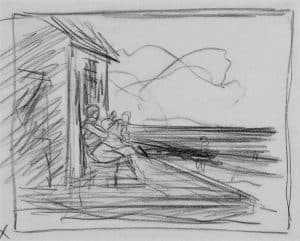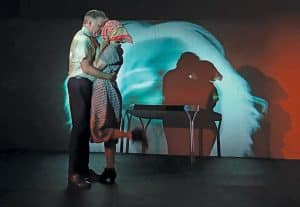Portrait of Margaret Mayo Expecting Motherhood (38″ X 31 ” oil on board) by Henry Hensche
by Steve Desroches
Art is everywhere you look in Provincetown. Since the inception of the Provincetown Art Colony when Charles Hawthorne founded the Cape Cod School of Art in 1899 the artists who have called the Cape tip home have expressed themselves in a myriad of ways. And over the past almost 125 years the town of Provincetown and its residents have been well documented capturing houses and ships that no longer exist as well as sweeping seascapes and skylines of town that remind us that the more things change the more they stay the same. But Provincetown is also in the unique position to have so many of its citizens captured in portraiture. Sitting for an artist can often feel like a rite of passage in Provincetown. In the early days many locals sat for art classes that turned out hundreds, if not thousands, of mudheads, in which the focus was on the form and not the details of the face. The subject would be backlit and a shadow would obscure the face and the art student would use a series of browns to fill in the face, thus the name. But soon townies would become the subjects of specific pieces, and while many of the names are lost to history, some went on to become artistic memorials to those featured. Antone Jason “Tony” Avellar modeled for a painting by his neighbor Gerrit A. Beneker, which would go on to become a famous World War I war bond poster titled Sure! We’ll Finish the Job. S. Edmund Oppenheim portrayed the “Poet of the Dunes” Harry Kemp with a seagull flying overhead in a celebrated 1955 oil on canvas. And photographer Nan Goldin frequently made photographs of Dreamlander Cookie Mueller in the 1970s, with prints of the work in museums all over the world. Admired by art lovers all around the globe, they can mean a whole lot more to those who live in Provincetown by what they capture.

That’s the case with the painting Portrait of Margaret Mayo Expecting Motherhood (38” x 31 ¨ oil on board) by Henry Hensche a piece that hangs in the Marc Jacobs Reading Room in the Provincetown Public Library and is in the Town’s collection. While the date is unknown, it’s almost assuredly painted in the 1930s based on the timeline of events in Mayo’s life. Born Margaret Adelaide Williams in Dorchester in 1908, young Margret moved to Provincetown as a teenager when her father became the chief of police. It’s at Provincetown High School that she met Herbert Mayo, a member of the large Mayo family that is still very much a part of Provincetown today. The two fell in love, but not everyone approved of the pairing. “They eloped to Wellfleet, like I did,” laughs David Mayo, their son who lives in the East End. “It runs in the family.”
On their impromptu wedding day, Alfred Mayo, Herbert’s brother who had never married and had no children, gifted them one of the “sea to sea” properties in town sprawling from the harbor at 610 Commercial Street all the way to the backshore so it would stay in the family. It’s there they would live their entire lives. The young couple, happy in love, began their lives together and started a family with the birth of the son Herbert Franklin Mayo II. But soon tragedy would strike. Their son died when he was only two years old from an unknown condition that affected his lungs and ability to breathe. The couple was devastated, and Margaret fell into a deep depression as grief consumed her. The community rallied around the Mayos, bringing food and gifts to their home in the hopes it might help ease their pain. But Margaret continued to disappear in a reclusive life.
“My grandparent were good friends with Henry Hensche and Ada [Raynor],” says Mayo. “In the winter they came over every Friday night for dinner. My grandfather asked Henry to ask my mother to sit for a painting as he was afraid she might not come back from the death of Herbert. He thought it was something that would get her out of the house.”
Margaret agreed to sit for the family friend. And while still deeply saddened by the loss of her son, she had good news. She was pregnant. And so Hensche created the portrait. Even if one didn’t know the story behind the painting one can sense the loss and grief in Margaret’s blue eyes. Her empty arms look longing to cradle as her slight slouch tells of the energy it must have taken for her to carry on, as it also gives the suggestion of her pregnancy about to show. When Margaret first saw the rendering she liked it very much, says Mayo, but later the painting became a source of anguish. After she’d seen it, Hensche innocently added in a child’s doll and baby’s clothing behind her, which for her were painful reminders of young Herbert. But soon tragedy would strike again. When she gave birth to another son, she and her husband named David, the baby died during childbirth.
She handled this next wave of grief differently, says Mayo. The Mayo family were good friends with famed Arctic explorers Donald and Miriam MacMillan, who over the years had gifted them with many items from their expeditions, including a hand-carved harpoon that graces the wall of the Mayo’s house today. They also gave the Mayo’s kayaks and mukluk boots. Soon after the death of her second child Margaret took to wearing the boots and in the summer traveled into town on said kayaks, attracting a lot of attention. She wanted a life of adventure and it showed.
The Mayos went on to have two more children, David and Katherine. And when Herbert died suddenly of a heart attack at age 59 in 1966, it’s as if she became a new woman, says Mayo, as she fought back grief with taking life head on. She traveled the world by herself, touring Australia, Africa, and Europe. She worked at the Pilgrim Monument and Provincetown Museum for 25 years, and was such a font of Provincetown history that when she retired the staff said they’d need to buy a computer to replace her mind. Margaret lived to 100, dying in 2009 in the same room in 610 Commercial Street where her young son’s wake had been held. She was a force until the very end.
“I always said that after my father died she became a woman, and not just a wife,” says Mayo. “She had a remarkable second life, if you will. Every time I go to the library I stop for a minute to look at the portrait. Every time.”











